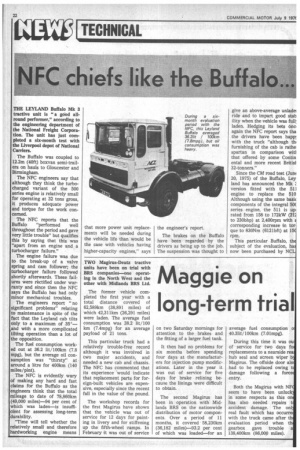THE LEYLAND Buffalo Mk 3 tractive unit is "a good
Page 24

If you've noticed an error in this article please click here to report it so we can fix it.
all round performer," according to the engineering department of the National Freight Corpora tion. The unit has just completed a six-month test with the Liverpool depot of National Carriers.
The Buffalo was coupled to 12.2m (40ft) boxvart semi-trailers on hauls to Gloucester and Birmingham.
The NFC engineers say that although they think the turbocharged variant of the 500 series engine is relatively small for operating at 32 tons gross, it produces adequate power and torque for the work concerned.
The NEC reports that the Buffalo "performed well throughout the period and gave very little trouble" but qualifies this by saying that this was "apart from an engine •and a turbocharger failure."
The engine failure was due to the break-up of a valve spring and cam follower; the turbocharger failure followed shortly afterwards. These failures were rectified under warranty and since then the NFC says the Buffalo has had only minor mechanical troubles.
The engineers report "no significant problems" relating to maintenance in spite of the fact that the Leyland cab tilts only to a maximum of 35`'— and with a more complicated tilting operation than a lot of the opposition.
The fuel consumption worked out at 36.2 lit/100km (7.8 mpg), but the average oil consumption was "thirsty" at • around a titre for 400km (140 miles/pint).
The NFC is evidently wary of making any hard and fast claims for the Buffalo as the engineers think that the total mileage to date of 78,860km (49,000 miles)-94 per cent of which was laden—is insufficient for assessing long-term durability.
"Time will tell whether the relatively small and therefore hardworking engine means that more power unit replacements will be needed during the vehicle life than would be the case with vehicles having higher-capacity engines," says the engineer's report.
The brakes on the Buffalo have been regarded by the drivers as being up to the job. The suspension was thought to give an above-average unlade ride and to impart good stab ility when the vehicle was full: laden. Hedging its bets ono again the NFC report says tha the drivers have been happ; with the truck "although th• furnishing of the cab is rathe spartan in comparison witl that offered by some Contin ental and more recent Britist 32-tonners."
Since the CM road test (Junk 20, 1975) of the Buffalo, Ley land has announced the Mk version fitted with the 511 engine to replace the 510 Although using the same bask components of the integral 50C series engine, the 511 is up rated from 158 to 172kW (21 to 230bhp) at 2,400rpm with corresponding increase in tor que to 830Nm (6121bft) at 15 rpm.
This particular Buffalo, th subject of the evaluation, ha now been purchased by NCL




















































































